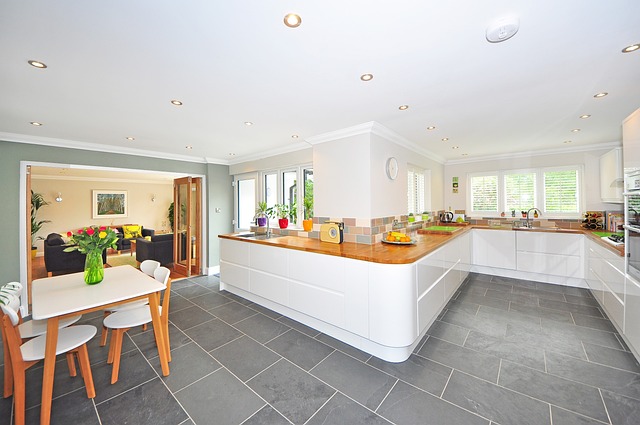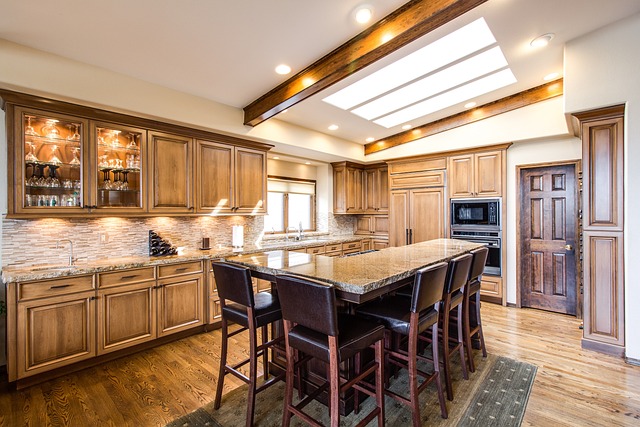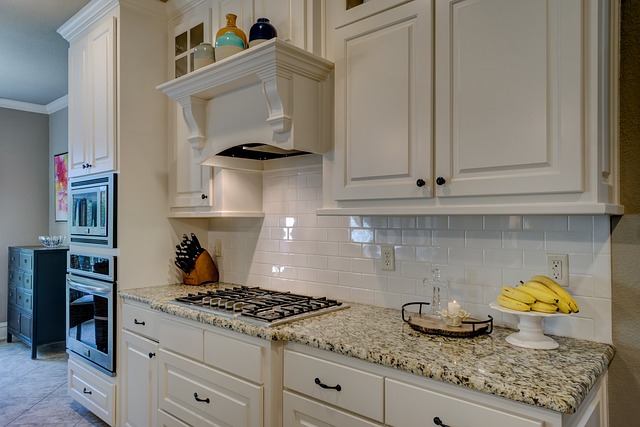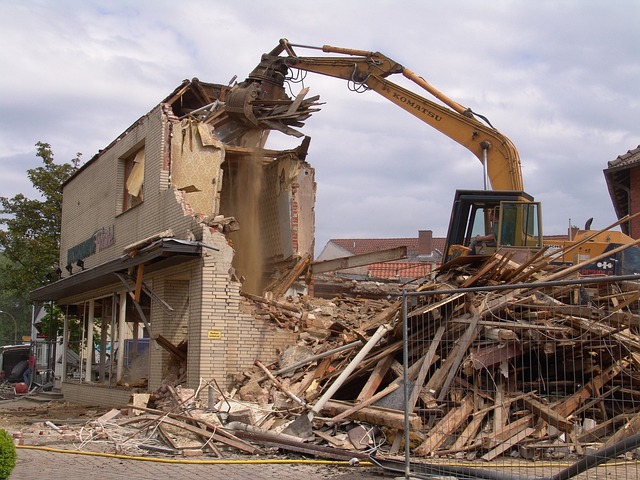Kitchen renovations often prioritize strategic lighting design to enhance both functionality and ambiance. Effective lighting transforms a kitchen from a mere utility space into a warm, inviting area that complements daily activities and entertaining. The integration of various lighting types—like recessed ceiling lights for general illumination, under-cabinet fixtures for task-specific clarity, and pendant lights over key areas for visual interest—creates a layered effect that emulates natural light. LED technology is embraced for its energy efficiency and versatility, offering options to adjust color temperatures and brightness to suit different activities and times of day. Smart lighting controls add convenience, allowing users to tailor the kitchen's lighting environment to their preferences and needs. In essence, a well-planned lighting strategy during kitchen renovations is crucial for creating a functional, adaptable, and visually appealing space that supports both culinary tasks and social interactions, all while promoting sustainable living practices. Keywords: Kitchen Renovations, Lighting Design, LED Technology, Energy Efficiency, Smart Controls, Ambiance, Functionality, Sustainability.
Illuminate your culinary space with precision and flair through the art of lighting design. This article delves into the transformative impact of lighting fixtures and design strategies on modern kitchen renovations, offering insights on optimizing your kitchen’s ambiance. From selecting ideal lighting solutions for different zones within your kitchen to leveraging LED technology for energy efficiency, discover how to blend natural and artificial light sources harmoniously. Enhance your cooking experience and the aesthetics of your kitchen with expert guidance on creating the perfect illumination setup—a critical aspect of any kitchen renovation project.
- The Role of Lighting Design in Modern Kitchen Renovations
- Assessing Your Kitchen Space for Effective Lighting Placement
- Choosing the Right Lighting Fixtures for Different Kitchen Areas
- LED Technology and Energy-Efficient Solutions for Kitchen Illumination
- Combining Natural and Artificial Light for a Balanced Ambiance in the Kitchen
The Role of Lighting Design in Modern Kitchen Renovations

In contemporary kitchen renovations, lighting design plays a pivotal role in enhancing functionality and ambiance. A well-planned lighting scheme can transform a mere functional space into a warm and inviting area that doubles as a social hub within the home. The strategic placement of recessed ceiling lights, under-cabinet fixtures, and pendant lights above the island or sink not only illuminates work surfaces but also creates layers of light that mimic natural daylight. This not only aids in food preparation and clean-up tasks but also makes the kitchen a comfortable place to gather. Kitchen renovations with thoughtfully integrated lighting can dramatically impact the overall feel of the space, whether homeowners are aiming for a modern minimalist look or a cozy, rustic ambiance. The selection of LED options, dimmable switches, and energy-efficient bulbs not only complements the aesthetic but also contributes to sustainable living practices. By considering the nuances of color temperature and the interplay between natural and artificial light sources, kitchen lighting design becomes an integral component of modern kitchen renovations, ensuring that the space serves both its practical purposes and as a visually appealing centerpiece of the home.
Assessing Your Kitchen Space for Effective Lighting Placement

When considering kitchen renovations, effective lighting design plays a pivotal role in crafting the perfect ambiance while enhancing functionality. Assessing your kitchen space for optimal lighting placement is an essential step to ensure that every corner is well-lit and inviting. Homeowners often focus on the aesthetic appeal of new cabinetry or countertops, yet the right lighting can make these elements truly shine. To start, evaluate the size and shape of your kitchen; this will determine the types of fixtures and their placement. Task lighting, such as under-cabinet lights, is crucial for precise food preparation and cooking tasks, reducing glare and ensuring visibility on countertops. Ambient lighting, like pendant lights over an island or a dining area, sets the overall tone and brightness level. Consider layering different types of lighting—combining task lighting with ambient options to create a versatile and cohesive design. Additionally, integrating dimmer switches allows for adjustability according to the time of day or the specific activities taking place in the kitchen, from morning coffee preparation to evening dinner parties. By thoughtfully planning your lighting layout during kitchen renovations, you can transform the space into a functional and warm environment that supports both culinary endeavors and social gatherings.
Choosing the Right Lighting Fixtures for Different Kitchen Areas

When embarking on kitchen renovations, selecting the right lighting fixtures is pivotal to enhance both functionality and ambiance. The kitchen, a space that serves as both a culinary workshop and a gathering spot, requires a thoughtful approach to illumination. Pendant lights over an island or sink are not just design elements; they provide focused task lighting and contribute to the overall aesthetic. Consider sleek, modern designs for contemporary kitchens or rustic options for a traditional look. Under-cabinet lighting serves a dual purpose: it offers practical light for chopping and meal preparation while eliminating shadows that can disrupt visibility. For overhead illumination, track lighting with adjustable spotlights can highlight art or functional areas like the stove or sink. Recessed lighting, strategically placed, casts a warm glow that complements both the space and its users. LED strips under cabinets or above toe-kick spaces offer an energy-efficient solution for subtle, ambient light. Each fixture should be chosen with the room’s layout and the tasks performed in mind to ensure a harmonious balance of form and function. Incorporating different types of lighting layers not only enhances the kitchen’s appeal during kitchen renovations but also makes it a versatile space that can adapt to various activities and moods throughout the day.
LED Technology and Energy-Efficient Solutions for Kitchen Illumination

In contemporary kitchen renovations, LED technology stands at the forefront of innovative lighting solutions, offering a compelling combination of energy efficiency and superior ambiance. The compact nature of LED bulbs allows for a multitude of creative design possibilities, from under-cabinet strips that highlight countertops to task lighting that illuminates workspaces with precision. These energy-efficient solutions not only reduce electricity consumption but also extend their lifespan significantly, eliminating the need for frequent replacements and contributing to a greener environment. The adjustable color temperatures of LED fixtures enable homeowners to tailor the lighting to suit both functional needs and desired moods, whether a warm white light for cozy family dinners or bright, cool whites for meticulous food preparation. Moreover, the adaptability of LED technology means that it can be seamlessly integrated into smart home systems, offering users control over their kitchen’s illumination with smart apps, voice commands, and even motion sensors, making kitchen renovations not just a visual upgrade but also a leap into the future of energy-conscious living.
Combining Natural and Artificial Light for a Balanced Ambiance in the Kitchen

kitchen renovations often prioritize functionality and aesthetics, with lighting design playing a pivotal role in achieving a harmonious ambiance. To create an environment that is both warm and inviting, designers recommend a judicious blend of natural and artificial light. Natural light is not just a sustainability feature but also a key element in setting the mood for a kitchen space. Strategically placed windows or skylights can flood the area with sunlight during daylight hours, contributing to energy efficiency and a sense of openness. When the sun’s position changes throughout the day, complementary artificial lighting systems should adapt accordingly to maintain the desired ambiance. LED task lights under cabinetry or above counter spaces can replace harsh fluorescent tubes, offering targeted illumination for cooking or food preparation without casting shadows. These fixtures, when paired with warm-toned ambient lighting, such as recessed ceiling lights or decorative pendant lamps, create a balanced and adaptive kitchen environment. The interplay of these two light sources not only enhances the visual appeal but also ensures that the kitchen is both functional and comfortable for all activities, from meal prep to entertaining guests. In the realm of kitchen renovations, integrating smart lighting controls further heightens this balance, allowing users to adjust brightness and color temperature to match the time of day or specific tasks, thereby transforming the kitchen into a versatile space that can cater to both practical needs and atmospheric requirements.
Kitchen lighting design plays a pivotal role in enhancing both the functionality and ambiance of modern kitchen renovations. By strategically placing and selecting the right fixtures, homeowners can achieve an optimal balance between task lighting for culinary activities and atmospheric lighting to set the perfect mood. The integration of LED technology not only offers energy-efficient solutions but also a wide array of options that cater to diverse design preferences. Whether you’re focusing on kitchen renovations or simply updating your current space, understanding how to combine natural light with artificial sources is key to creating a warm and inviting environment. With careful consideration of each area within the kitchen, the end result is a space that not only serves its practical purposes but also becomes a statement of personal style and comfort.
